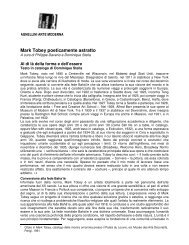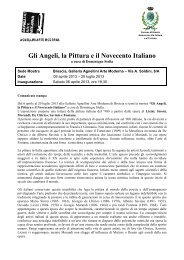Shin production | Agnellini Arte ModernA - Galleria Agnellini Arte ...
Shin production | Agnellini Arte ModernA - Galleria Agnellini Arte ...
Shin production | Agnellini Arte ModernA - Galleria Agnellini Arte ...
Create successful ePaper yourself
Turn your PDF publications into a flip-book with our unique Google optimized e-Paper software.
il suo essere e la sua arte. la fede mondiale bahá’í è una dottrina universale. essa<br />
accompagna l’umanità verso una coscienza profonda della propria condizione, nel rispetto<br />
dell’essere e della natura. l’unità è il suo principio fondamentale. per raggiungerla, essa<br />
auspica la fondazione di una comunità universale in cui tutte le nazioni, razze, classi e<br />
religioni siano strettamente e inderogabilmente unite, in cui l’autonomia degli Stati membri<br />
e la libertà personale, così come l’iniziativa degli individui che la compongono, siano<br />
pienamente e per sempre tutelate. essa aspira all’abolizione dei pregiudizi, intende stabilire<br />
l’uguaglianza dei sessi, lottare contro la schiavitù e distribuire equamente le ricchezze di<br />
questo mondo. Questa comunità universale comporta una legislatura universale i cui membri,<br />
in quanto rappresentanti della razza umana, hanno il controllo supremo su tutte le risorse<br />
delle nazioni che la compongono ed emanano le leggi necessarie a regolamentare la vita,<br />
rispondere alle necessità e armonizzare le relazioni di tutti i popoli e di tutti le razze. i baha’ié<br />
credono in un dio universale e a-temporale, che avrebbe eletto fra gli uomini alcune guide<br />
spirituali appartenenti a diversi credo. che si tratti di gesù, Maometto, buddha o confucio,<br />
tutti i profeti rappresentano un medesimo spirito, una medesima forza divina superiore,<br />
la cui conoscenza e rivelazione è accessibile a tutti. Sin dai suoi esordi, la fede bahá’í<br />
professa insegnamenti rivoluzionari per l’epoca: essa richiama all’uguaglianza fra i sessi,<br />
of its condition in accordance with being and nature. its fundamental principle is unity. to<br />
achieve that unity, it advocates the establishment of a universal community in which all<br />
nations, peoples, classes and religions are closely and definitively united, and in which<br />
the autonomy of the member States and personal freedom, as well as the initiative of<br />
its individual members, are completely and permanently upheld. its goals are to abolish<br />
prejudice, to establish sexual equality, to fight slavery, and to share the riches of the<br />
world equally. this universal community entails a universal legislature whose members,<br />
as representatives of the human race, have supreme control of all the resources of its<br />
member nations, and enact the laws necessary for governing life, meeting needs, and<br />
harmonising relations between all peoples. Members of the bahá’í Faith believe in a<br />
universal and timeless god who chose the individuals who became the spiritual guides for<br />
the different faiths. Jesus, Muhammad, the buddha, confucius and all prophets represent<br />
the same spirit, the same divine force that is available to all. At the time of its foundation,<br />
the bahá’í Faith preached revolutionary teachings: it called for gender equality, the<br />
compatibility of science and religion, the relativity of truth (including religious truth), and<br />
the absolute uniqueness of the human race. if these principles represented a challenge,<br />
even to the liberalism of nineteenth-century europe, the shock was much greater to the<br />
m a r k t o b e y 20 21 m a r k t o b e y<br />
alla compatibilità della scienza e della religione, alla relatività della verità (compresa quella<br />
religiosa) e all’unicità assoluta del genere umano. Se questi principi costituivano una sfida – al<br />
liberalismo europeo del XiX secolo, tra gli altri – che dire dello shock di cui risentì il mondo<br />
islamico, allora ripiegato sul proprio assolutismo. tre personaggi illustri hanno condotto<br />
questa rivoluzione nata dall’islam. il primo si chiamava ’Ali-Muhammad Shirazi (1819-1850),<br />
noto come “il bab” (la porta, intendendo “la porta aperta sulla nuova era”). ci fu poi Mirza<br />
husayn-’Ali (1817-1892), che avrebbe preso il titolo di “baha’u’llah” (gloria di dio), e a cui<br />
subentrò il primogenito ’Abdu’l-baha (Servo di dio, 1844-1921). tutto ha inizio nel 1844, nella<br />
città persiana di Shiraz. “il bab” dichiara di essere “il Mihdi” (“colui che è guidato da dio”). il<br />
suo insegnamento, in un primo tempo, si limita a un gruppo di diciotto discepoli. grazie alla<br />
diffusione dei suoi scritti, tuttavia, esso raggiunge un numero sempre più grande di persone,<br />
di ogni estrazione sociale, sino a coinvolgere il grande pubblico. il grottesco processo a cui<br />
sarà sottoposto a tabriz, nel 1848, per “deviazione religiosa” , alla conclusione del quale egli<br />
viene severamente bastonato, non farà che accrescere la sua notorietà.<br />
Questa nuova religione avrebbe esercitato un forte impatto sull’opera dell’artista: “Fu davvero<br />
un bivio spirituale cruciale nella vita di tobey e nella sua opera”, scriveva William Seitz, in<br />
un articolo del catalogo alla mostra di Mark tobey presso il Museo d’<strong>Arte</strong> Moderna di new<br />
islamic world, which fell back on its absolutist nature. the baha’í revolution, which grew<br />
out of islam, was led by three individuals: the first was ’Ali-Muhammad Shirazi (1819–50),<br />
known as “el-bab” (the gate, signifying “the gate that opens onto a new era”); the second<br />
was Mirza husayn-’Ali (1817–92), who took the title of “baha’u’llah” (meaning “the glory<br />
of god”); and the third was his eldest son ’Abdu’l-baha (Servant of god, 1844–1921). it<br />
all began in 1844 in the small persian town of Shiraz. el-bab declared himself to be<br />
“the Mihdi” (“he who is guided by god”). originally his teaching was limited to a circle of<br />
eighteen disciples but, once his writings began to circulate, a growing number of people<br />
from all social strata began to follow him, to the extent that he finished by attracting a<br />
large public. the ludicrous legal case brought against him in tabriz in 1848 for “religious<br />
deviance”, for which his punishment was a severe beating, only served to increase his<br />
fame.<br />
tobey’s new religion must have had a strong impact on his work: “it was truly a crucial<br />
spiritual junction in tobey’s life and in his work”, wrote William Seitz in the catalogue of<br />
the exhibition of the artist’s works in new york’s Museum of Modern Art (1962). tobey’s<br />
world is subjective and his art essentially tied to a mental attitude that presides over the<br />
construction of his painting, resulting in a form that expresses interior contemplation












